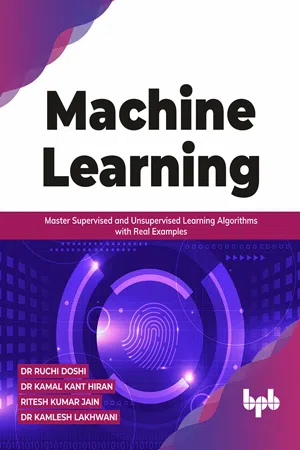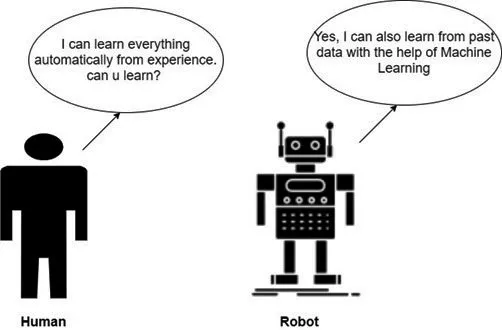
Machine Learning
Master Supervised and Unsupervised Learning Algorithms with Real Examples (English Edition)
- English
- ePUB (mobile friendly)
- Available on iOS & Android
Machine Learning
Master Supervised and Unsupervised Learning Algorithms with Real Examples (English Edition)
About this book
Concepts of Machine Learning with Practical Approaches.
Key Features
? Includes real-scenario examples to explain the working of Machine Learning algorithms.
? Includes graphical and statistical representation to simplify modeling Machine Learning and Neural Networks.
? Full of Python codes, numerous exercises, and model question papers for data science students.
Description
The book offers the readers the fundamental concepts of Machine Learning techniques in a user-friendly language. The book aims to give in-depth knowledge of the different Machine Learning (ML) algorithms and the practical implementation of the various ML approaches.This book covers different Supervised Machine Learning algorithms such as Linear Regression Model, Naïve Bayes classifier Decision Tree, K-nearest neighbor, Logistic Regression, Support Vector Machine, Random forest algorithms, Unsupervised Machine Learning algorithms such as k-means clustering, Hierarchical Clustering, Probabilistic clustering, Association rule mining, Apriori Algorithm, f-p growth algorithm, Gaussian mixture model and Reinforcement Learning algorithm such as Markov Decision Process (MDP), Bellman equations, policy evaluation using Monte Carlo, Policy iteration and Value iteration, Q-Learning, State-Action-Reward-State-Action (SARSA). It also includes various feature extraction and feature selection techniques, the Recommender System, and a brief overview of Deep Learning.By the end of this book, the reader can understand Machine Learning concepts and easily implement various ML algorithms to real-world problems.
What you will learn
? Perform feature extraction and feature selection techniques.
? Learn to select the best Machine Learning algorithm for a given problem.
? Get a stronghold in using popular Python libraries like Scikit-learn, pandas, and matplotlib.
? Practice how to implement different types of Machine Learning techniques.
Who this book is for
This book is designed for data science and analytics students, academicians, and researchers who want to explore the concepts of machine learning and practice the understanding of real cases. Knowing basic statistical and programming concepts would be good, although not mandatory.
Table of Contents
1. Introduction
2. Supervised Learning Algorithms
3. Unsupervised Learning
4. Introduction to the Statistical Learning Theory
5. Semi-Supervised Learning and Reinforcement Learning
6. Recommended Systems
About the Authors
Dr Ruchi Doshi has more than 14 years of academic, research, and software development experience in Asia and Africa. Currently, she is working as a research supervisor at the Azteca University, Mexico, and as an adjunct faculty at the Jyoti Vidyapeeth Women's University, Jaipur, Rajasthan, India. She has also worked with the BlueCrest University College, Liberia, West Africa as a Registrar and Head, Examination; BlueCrest University College, Ghana, Africa; Amity University, Rajasthan, India; Trimax IT Infrastructure & Services, Udaipur, India. Kamal Kant Hiran works as an Assistant Professor, School of Engineering at the Sir Padampat Singhania University (SPSU), Udaipur, Rajasthan, India as well as a Research Fellow at the Aalborg University, Copenhagen, Denmark. He is a Gold Medalist in M.Tech. (Hons.). He has more than 16 years of experience as an academic and researcher in Asia, Africa, and Europe. Ritesh Kumar Jain works as an Assistant Professor, at the Geetanjali Institute of Technical Studies, (GITS), Udaipur, Rajasthan, India. He has more than 15 years of teaching and research experience. Dr. Kamlesh Lakhwani works as an Associate Professor, in Computer Science & Engineering at JECRC University Jaipur, Rajasthan, India. He has an excellent academic background and a rich experience of 15 years as an academician and researcher in Asia.
Frequently asked questions
- Essential is ideal for learners and professionals who enjoy exploring a wide range of subjects. Access the Essential Library with 800,000+ trusted titles and best-sellers across business, personal growth, and the humanities. Includes unlimited reading time and Standard Read Aloud voice.
- Complete: Perfect for advanced learners and researchers needing full, unrestricted access. Unlock 1.4M+ books across hundreds of subjects, including academic and specialized titles. The Complete Plan also includes advanced features like Premium Read Aloud and Research Assistant.
Please note we cannot support devices running on iOS 13 and Android 7 or earlier. Learn more about using the app.
Information
CHAPTER 1
Introduction to Machine Learning
Introduction
Structure
- What is Machine Learning?
- Machine Learning Vs. Traditional Programming
- The Seven Steps of Machine Learning
- Types of Machine Learning
- Advantages and disadvantages of Machine Learning
- Popular Machine Learning Software Tools
- Tools used for practical with some examples
Objectives
- Understand the concepts of Machine Learning.
- Understand the difference Between Traditional programming & Machine Learning.
- Understand about the state-of-art applications of Machine Learning.
- Understand about the types of Machine Learning.
- Understand the significance of the Machine Learning applications
- Understand about the tools of Machine Learning
What is Machine Learning?


- Task (T): The task of playing chess
- Experience (E): The experience of playing many games of chess
- Performance Measure (P): The probability of the program which will win the next game of chess
- Task (T): To recognize and classify the emails into 'spam' or 'not spam'.
- Experience (E): A set of emails with given labels ('spam' / 'not spam').
- Performance Measure (P): Total percentage of emails being correctly classified as 'spam' (or 'not spam’) by the program.
Machine Learning versus Traditional Programming


The Seven Steps of Machine Learning

Step 1: Data Gathering / Data Collection
Table of contents
- Cover Page
- Title Page
- Copyright Page
- Foreword
- Dedication Page
- About the Authors
- About the Reviewer
- Acknowledgement
- Preface
- Errata
- Table of Contents
- 1. Introduction to Machine Learning
- 2. Supervised Learning Algorithms
- 3. Unsupervised Learning
- 4. Introduction to Statistical Learning Theory
- 5. Semi-Supervised Learning, Reinforcement Learning
- 6. Recommended Systems
- Bibliography
- Practicals
- Test Papers
- Index